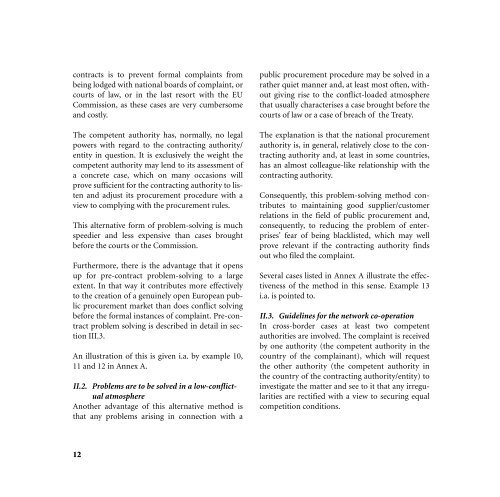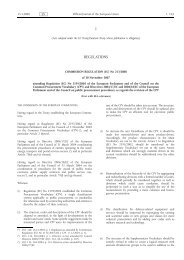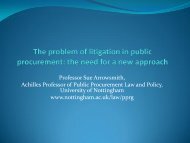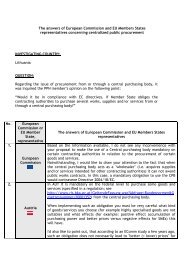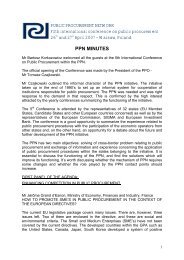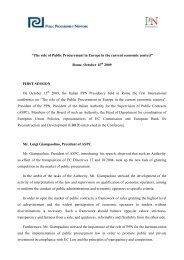Download the document (PDF file) - Public Procurement Network
Download the document (PDF file) - Public Procurement Network
Download the document (PDF file) - Public Procurement Network
You also want an ePaper? Increase the reach of your titles
YUMPU automatically turns print PDFs into web optimized ePapers that Google loves.
contracts is to prevent formal complaints from<br />
being lodged with national boards of complaint, or<br />
courts of law, or in <strong>the</strong> last resort with <strong>the</strong> EU<br />
Commission, as <strong>the</strong>se cases are very cumbersome<br />
and costly.<br />
The competent authority has, normally, no legal<br />
powers with regard to <strong>the</strong> contracting authority/<br />
entity in question. It is exclusively <strong>the</strong> weight <strong>the</strong><br />
competent authority may lend to its assessment of<br />
a concrete case, which on many occasions will<br />
prove sufficient for <strong>the</strong> contracting authority to listen<br />
and adjust its procurement procedure with a<br />
view to complying with <strong>the</strong> procurement rules.<br />
This alternative form of problem-solving is much<br />
speedier and less expensive than cases brought<br />
before <strong>the</strong> courts or <strong>the</strong> Commission.<br />
Fur<strong>the</strong>rmore, <strong>the</strong>re is <strong>the</strong> advantage that it opens<br />
up for pre-contract problem-solving to a large<br />
extent. In that way it contributes more effectively<br />
to <strong>the</strong> creation of a genuinely open European public<br />
procurement market than does conflict solving<br />
before <strong>the</strong> formal instances of complaint. Pre-contract<br />
problem solving is described in detail in section<br />
III.3.<br />
An illustration of this is given i.a. by example 10,<br />
11 and 12 in Annex A.<br />
II.2. Problems are to be solved in a low-conflictual<br />
atmosphere<br />
Ano<strong>the</strong>r advantage of this alternative method is<br />
that any problems arising in connection with a<br />
public procurement procedure may be solved in a<br />
ra<strong>the</strong>r quiet manner and, at least most often, without<br />
giving rise to <strong>the</strong> conflict-loaded atmosphere<br />
that usually characterises a case brought before <strong>the</strong><br />
courts of law or a case of breach of <strong>the</strong> Treaty.<br />
The explanation is that <strong>the</strong> national procurement<br />
authority is, in general, relatively close to <strong>the</strong> contracting<br />
authority and, at least in some countries,<br />
has an almost colleague-like relationship with <strong>the</strong><br />
contracting authority.<br />
Consequently, this problem-solving method contributes<br />
to maintaining good supplier/customer<br />
relations in <strong>the</strong> field of public procurement and,<br />
consequently, to reducing <strong>the</strong> problem of enterprises’<br />
fear of being blacklisted, which may well<br />
prove relevant if <strong>the</strong> contracting authority finds<br />
out who <strong>file</strong>d <strong>the</strong> complaint.<br />
Several cases listed in Annex A illustrate <strong>the</strong> effectiveness<br />
of <strong>the</strong> method in this sense. Example 13<br />
i.a. is pointed to.<br />
II.3. Guidelines for <strong>the</strong> network co-operation<br />
In cross-border cases at least two competent<br />
authorities are involved. The complaint is received<br />
by one authority (<strong>the</strong> competent authority in <strong>the</strong><br />
country of <strong>the</strong> complainant), which will request<br />
<strong>the</strong> o<strong>the</strong>r authority (<strong>the</strong> competent authority in<br />
<strong>the</strong> country of <strong>the</strong> contracting authority/entity) to<br />
investigate <strong>the</strong> matter and see to it that any irregularities<br />
are rectified with a view to securing equal<br />
competition conditions.<br />
12


